Worried your medical display might fail when you need it most? High brightness is crucial, but pushing limits can be risky. Understanding brightness overdrive is key to display longevity.
Yes, sustained brightness overdrive can lead to premature panel failure. It accelerates the degradation of backlight components, particularly LEDs, due to increased heat and electrical stress, ultimately shortening the display’s operational lifespan.
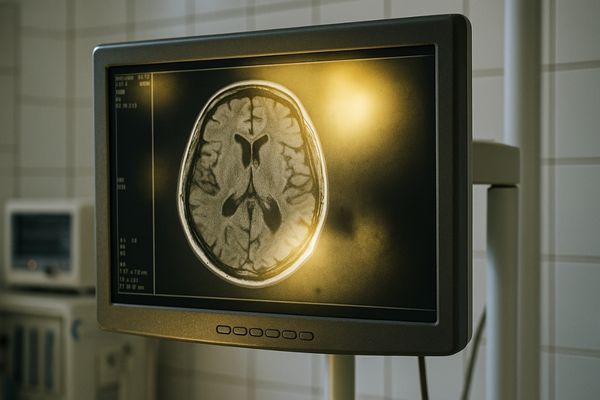
The luminance of a medical display is a critical factor in its usability, especially in demanding clinical environments. However, constantly operating a display at its peak brightness, or in an "overdrive" mode, carries inherent risks. We will explore what brightness overdrive1 entails, why it is sometimes necessary, and how it can affect the delicate components of a display panel. We will also discuss how responsible manufacturers2 manage these factors to ensure reliability.
What is brightness overdrive and how is it used in medical displays?
Heard of brightness overdrive but unsure what it means for your display? It sounds like a performance boost, but there are trade-offs. Let’s clarify its role.
Brightness overdrive pushes a display’s luminance to its maximum designed limit, or temporarily beyond, to enhance visibility in very bright ambient conditions, such as direct surgical lighting. It’s a feature for critical, short-term viewing needs.
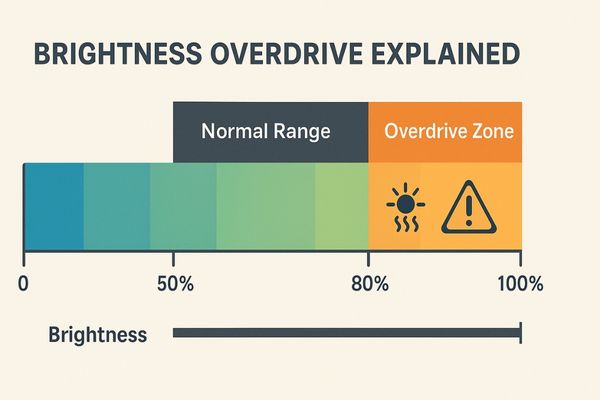
I understand brightness overdrive3 as a specific operational mode for a display. It is designed to maximize the light output from the screen. This is typically achieved by driving the backlight system, usually composed of Light Emitting Diodes (LEDs), at or near their highest power capacity. Some systems might even allow for short bursts exceeding the nominal maximum, though this is less common in medical displays designed for sustained use. The primary purpose in a medical context is to ensure that the image on the screen remains clearly visible even when competing with intense ambient light. For example, during an endoscopic surgery, powerful overhead lights illuminate the surgical field, and the surgical display must be bright enough to overcome any glare and allow the surgeon to see critical anatomical details. Similarly, in some diagnostic settings with bright ambient lighting, higher screen luminance can improve image perception. However, it’s important to recognize that this mode is often intended for temporary or intermittent use rather than continuous operation.
Mechanisms of Brightness Overdrive
Achieving overdrive involves careful control of the display’s internal components.
- Increased LED Current: The most direct way to boost brightness is by increasing the electrical current supplied to the LEDs in the backlight unit.
- Pulse Width Modulation (PWM) Adjustment: For LEDs controlled by PWM, increasing the duty cycle (the proportion of time the LEDs are on) can also increase perceived brightness, up to the point where they are continuously on.
- Dynamic Brightness Control4: Some advanced displays might use sensors to detect ambient light and automatically adjust brightness, potentially entering an overdrive state only when necessary.
This functionality provides an essential tool for visibility but needs to be managed carefully to avoid detrimental effects on the display’s lifespan, a concern we will delve into later.
Why do some clinical environments demand high-brightness settings?
Ever struggled to see a screen clearly in a brightly lit operating room? Certain medical tasks require exceptionally bright displays. This demand is driven by specific environmental factors.
Clinical environments like operating rooms with intense surgical lights, or radiology reading rooms with specific illumination standards, demand high-brightness displays to ensure clear image visibility, overcome glare, and maintain diagnostic accuracy.
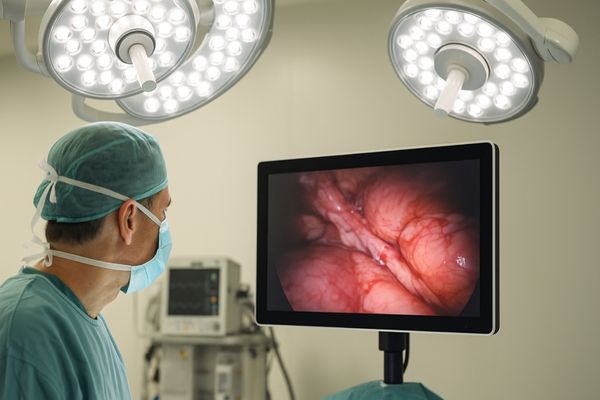
I have observed that the need for high brightness in medical displays5 is directly linked to the ambient lighting conditions6 and the nature of the clinical task. In operating rooms, surgical lights are extremely intense, often exceeding 100,000 lux directly on the surgical site. While the display is not directly under these lights, the scattered light and general room illumination can still be very high. A display with insufficient brightness would appear washed out, making it difficult for the surgical team to discern subtle tissue variations or instrument positions on the monitor. Similarly, interventional radiology suites often have bright lighting to support the procedural aspects, requiring displays with high luminance for clear fluoroscopic imaging. Even in diagnostic reading rooms, while ambient light is more controlled, specific tasks or multi-modality image comparisons might benefit from higher display brightness to perceive the full dynamic range of medical images, especially when viewing alongside brighter film illuminators or other displays. The fundamental reason is to maintain an adequate contrast ratio7 between the image on the screen and the surrounding light, ensuring that the darkest parts of the image are still distinguishable and the brightest parts are not clipped.
Brightness Requirements in Different Clinical Settings
The optimal display brightness can vary significantly based on the environment.
| Clinical Setting | Typical Ambient Light | Display Brightness Considerations | Common Target Luminance (cd/m²) |
|---|---|---|---|
| Operating Room (Surgical) | Very High (Surgical Lamps) | Overcome direct/indirect glare, critical detail visibility | 800 – 1000+ |
| Interventional Radiology | High | Clear visibility of dynamic imaging during procedures | 600 – 800 |
| Diagnostic Reading Room (PACS) | Controlled, Dim | Accurate grayscale, subtle lesion detection | 350 – 500 (calibrated) |
| Emergency Room | Variable, often Bright | Quick assessment, robust performance | 400 – 600 |
| Patient Bedside | Moderate to Bright | Patient monitoring, information display | 250 – 400 |
This table illustrates that "high brightness" is relative but consistently sought in environments where ambient light poses a challenge to clear visualization. For instance, our MD120C can achieve very high brightness levels suitable for demanding applications.
What are the risks of operating displays at maximum brightness for extended periods?
Is it safe to run your medical display at full brightness all day? While sometimes necessary, continuous maximum output can cause problems. Understanding these risks is crucial for display management.
Operating displays at maximum brightness for extended periods elevates component temperatures, accelerates luminance decay of the backlight (especially LEDs), increases power consumption, and can potentially lead to premature failures like color shifts or uneven brightness.
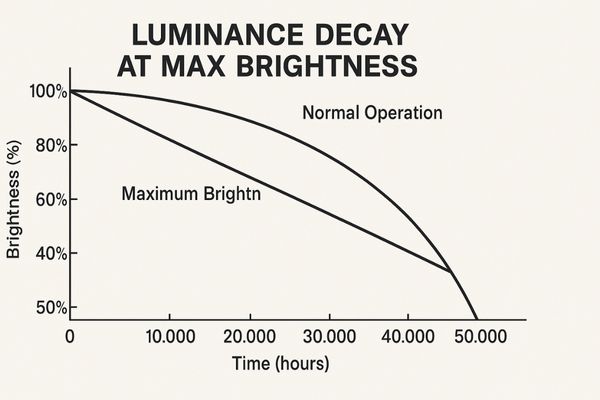
I always advise caution regarding the prolonged use of displays at their absolute maximum brightness8. While displays are designed to operate within their specified brightness range, consistently pushing them to the upper limit, especially for many hours a day, significantly stresses their components. The primary concern is heat. The LED backlight units generate more heat when driven at higher currents to produce maximum brightness. If this additional heat is not effectively dissipated by the display’s thermal management system9, it can lead to several issues. Internal temperatures rise, which can accelerate the aging process of various components, not just the LEDs. This can manifest as a faster decline in luminance output over time – the display becomes dimmer sooner in its lifespan than it would if operated at more moderate brightness levels. Furthermore, excessive heat can affect the liquid crystal panel itself and the associated electronics, potentially leading to color inaccuracies, image retention10 (burn-in), or even catastrophic failure of driver ICs or power supply components. The increased power consumption also means higher operational costs and a greater environmental footprint.
Consequences of Sustained High Brightness
Continuous operation at peak luminance introduces several stress factors.
- Accelerated LED Aging11: The primary failure mode for LEDs is gradual lumen depreciation (dimming). Higher operating currents and temperatures significantly speed up this process.
- Thermal Stress on Components12: Other electronic components on the display’s circuit boards, like capacitors and processors, are also susceptible to heat-induced degradation. Elevated temperatures can shorten their lifespan.
- Color Shift: Over time, the spectral output of LEDs can change due to aging, and this can be exacerbated by high operational stress. This may lead to inaccuracies in color reproduction, which is critical in medical imaging.
- Increased Power Consumption13: Driving LEDs at maximum brightness requires more power, leading to higher energy costs and potentially straining the power supply unit if it’s not robustly designed for continuous peak load.
These factors collectively contribute to a reduced mean time between failures (MTBF) for the display.
How does overdrive affect backlight components and panel lifespan?
Curious about what exactly happens inside a display during brightness overdrive? This mode directly impacts the backlight. The effects on these components can significantly shorten the panel’s life.
Brightness overdrive pushes backlight LEDs harder, generating more heat and electrical stress. This accelerates LED degradation, reduces their efficiency, and can shorten the overall panel lifespan by causing premature dimming or backlight failure.
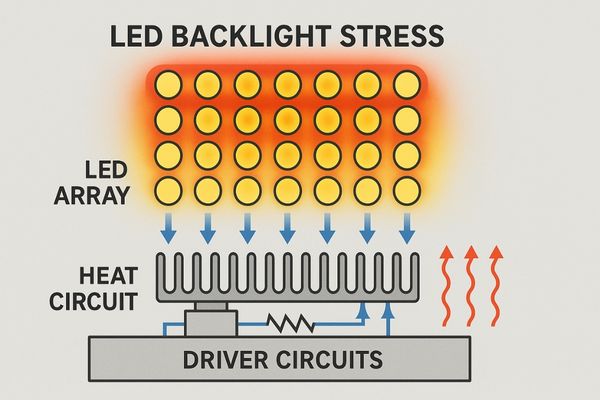
I find that the backlight unit, typically comprising an array of LEDs, is the component most directly affected by brightness overdrive14. When these LEDs are driven at or above their nominal maximum current to produce very high brightness, several detrimental processes are accelerated. The increased current flow generates more heat within the LED semiconductor junction. This junction temperature is a critical factor in LED lifespan; higher temperatures lead to faster degradation of the light-emitting materials and the encapsulant. This degradation manifests as a gradual reduction in light output (lumen depreciation15) and can also cause shifts in the color temperature of the emitted light. Over prolonged periods of overdrive, some LEDs might fail entirely, leading to dark spots or uneven brightness across the screen. The power supply unit (PSU) that drives these LEDs also experiences increased load and thermal stress, potentially shortening its lifespan. While a display panel itself (the liquid crystal layer) is not directly "overdriven" in terms of brightness, its performance and longevity can be indirectly affected by the increased heat generated by a persistently overdriven backlight system.
Impact on Backlight System Longevity
The relationship between operating conditions and LED lifespan16 is well-documented.
| Operating Condition | Impact on LED Lifespan | Consequence for Display |
|---|---|---|
| Nominal Brightness | Gradual, predictable lumen depreciation (e.g., L70 at 50,000 hours) | Expected lifespan, consistent performance |
| Sustained Max Brightness | Accelerated lumen depreciation (e.g., L70 at 20,000-30,000 hours) | Shorter effective lifespan, earlier dimming |
| Intermittent Overdrive | Moderately accelerated depreciation, heat spikes | Reduced lifespan, risk of thermal stress if cooling is inadequate |
| Continuous Overdrive | Rapid lumen depreciation, increased failure rate | Significantly shortened lifespan, higher risk of early failure |
L70 refers to the time it takes for the LED to reduce to 70% of its initial lumen output.
These figures are illustrative, as actual lifespans depend on specific LED quality, thermal design, and usage patterns. However, the trend is clear: more stress equals shorter life.
How does Reshin manage brightness output to ensure longevity?
Concerned about display lifespan given the need for high brightness? Responsible design is key. We implement specific strategies to balance performance with durability in our medical displays.
Reshin manages brightness output through smart brightness regulation, robust thermal management systems, built-in panel tolerance buffers, and high-quality component selection. This ensures display longevity even under demanding high-luminance operating conditions.
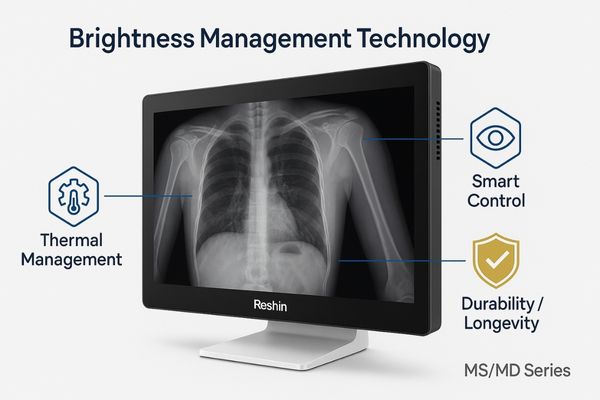
At Reshin, we are acutely aware of the balancing act between providing the high brightness levels our medical professional customers require and ensuring the long-term reliability of our displays. Our approach is multi-faceted. Firstly, we incorporate smart brightness regulation17 algorithms. These systems can monitor usage patterns and ambient conditions, potentially adjusting brightness to optimal levels automatically or providing clear guidance to users. Secondly, robust thermal management18 is integral to our design philosophy. This includes efficient heatsinks, optimized airflow paths within the display housing, and sometimes the use of thermally conductive materials to draw heat away from critical components like the LED backlight and power supply. We also design with panel tolerance buffers. This means selecting LED backlights and panels that are rated for higher performance than strictly required for the specified maximum brightness, providing a margin of safety and reducing stress when operating at peak levels. Furthermore, we are meticulous about component selection19, sourcing high-quality LEDs and power components known for their durability and resilience to thermal stress. For example, some of our advanced diagnostic monitors are engineered to sustain high brightness levels consistently due to these integrated protective measures. This careful engineering ensures that even when our displays are used in high-brightness modes, they are operating within safe thermal and electrical limits, thereby maximizing their operational lifespan and providing a reliable return on investment.
Key Longevity-Ensuring Strategies
Our commitment to durability is reflected in our design and manufacturing processes.
- Advanced Thermal Design: We use passive and, where necessary, active cooling solutions. This includes careful placement of components to optimize heat dissipation and prevent hotspots.
- Current Limiting Circuits: Protective circuits ensure that LEDs are not driven beyond their safe operating current, even if a user attempts to push brightness excessively through service menus (which we generally lock).
- Backlight Stabilization: Some models feature sensors that monitor the backlight output and adjust drive currents to maintain consistent brightness over time, compensating for initial LED aging without undue stress.
- Quality Control and Testing: Rigorous testing, including prolonged operation at high brightness and temperature cycling, helps us validate the durability of our designs before they reach the customer.
These measures collectively contribute to displays that can withstand the rigors of clinical use without premature failure due to brightness-related stress.
Conclusion
Brightness overdrive offers temporary visual enhancement but poses risks if used constantly. Smart design and proper usage are crucial for ensuring medical display longevity and reliable performance. To learn how Reshin balances brightness performance and panel protection, contact us at martin@reshinmonitors.com.
-
Understanding brightness overdrive is essential for ensuring optimal performance and longevity of medical displays in clinical settings. ↩
-
Learning about the practices of responsible manufacturers can help in selecting high-quality medical displays that meet safety standards. ↩
-
Explore this link to understand how brightness overdrive enhances display performance, especially in critical medical settings. ↩
-
Discover how Dynamic Brightness Control optimizes display brightness based on ambient light, enhancing visibility and user experience. ↩
-
Understanding the significance of brightness in medical displays can enhance image clarity and improve clinical outcomes. ↩
-
Exploring this topic can reveal how lighting impacts image quality and diagnostic accuracy in medical settings. ↩
-
Learning about contrast ratios can help in selecting the right displays for accurate medical imaging and diagnostics. ↩
-
Understanding the effects of maximum brightness can help you make informed decisions about display usage and longevity. ↩
-
Exploring thermal management systems can provide insights into how displays maintain performance and prevent damage from heat. ↩
-
Learning about image retention can help you avoid common pitfalls and extend the life of your display. ↩
-
Understanding accelerated LED aging can help you mitigate risks and enhance the longevity of your displays. ↩
-
Exploring thermal stress impacts can guide you in designing more reliable and durable electronic systems. ↩
-
Learning about power consumption implications can help optimize energy efficiency and reduce operational costs. ↩
-
Understanding brightness overdrive is crucial for optimizing LED performance and longevity. Explore this link for in-depth insights. ↩
-
Lumen depreciation impacts light quality and efficiency. Learn more about its causes and effects to make informed decisions. ↩
-
Temperature plays a vital role in LED lifespan. Discover detailed studies and findings on this topic to enhance your knowledge. ↩
-
Explore how smart brightness regulation enhances display performance and longevity, crucial for medical professionals. ↩
-
Learn about the importance of thermal management in ensuring the reliability and lifespan of medical displays. ↩
-
Discover how high-quality component selection impacts the durability and performance of medical displays. ↩


